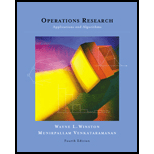
Concept explainers
Explanation of Solution
Optimal solution:
Consider the following linear programing problem:
Subject to the constraints:
Use
Subject to the constraints:
Add slack variables s1,s2 and artificial variable a1 to get:
-(min w′ = -5x1+x2+a1)
Subject to the constraints:
Two Phase Method:
Phase I linear programming problem is,
Subject to the constraints:
The initial simplex table is given below:
| w′ | x1 | x2 | a1 | s1 | s2 | rhs | basic variable | |
| R0 | 1 | 0 | 0 | -1 | 0 | 0 | 0 | w′=0 |
| R1 | 0 | 2 | 1 | 1 | 0 | 0 | 6 | a1=6 |
| R2 | 0 | 1 | 1 | 0 | 1 | 0 | 4 | s1=4 |
| R3 | 0 | 1 | 2 | 0 | 0 | 1 | 5 | s2=5 |
- Since, the basic variable a1 value in R0 is non-zero, therefore, do the transformations
| w′ | x1 | x2 | a1 | s1 | s2 | rhs | basic variable | |
| R0 | 1 | 0 | 0 | -1 | 0 | 0 | 0 | w′=0 |
| R1 | 0 | 2 | 1 | 1 | 0 | 0 | 6 | a1=6 |
| R2 | 0 | 1 | 1 | 0 | 1 | 0 | 4 | s1=4 |
| R3 | 0 | 1 | 2 | 0 | 0 | 1 | 5 | s2=5 |
Since the highest positive entry 2 in R0 corresponds to x1, x1 enters the basis.
| w′ | x1 | x2 | a1 | s1 | s2 | rhs | ratio | |
| R0 | 1 | 2 | 1 | 0 | 0 | 0 | 6 | - |
| R1 | 0 | 2 | 1 | 1 | 0 | 0 | 6 | 3* |
| R2 | 0 | 1 | 1 | 0 | 1 | 0 | 4 | 4 |
| R3 | 1 | 2 | 0 | 0 | 0 | 1 | 5 | 5 |
Apply the simplex method further:
| w′ | x1 | x2 | a1 | s1 | s2 | rhs | basic variable | |
| R0 | 1 | 0 | 0 | -1 | 0 | 0 | 0 | w′=0 |
| R1 | 0 | 1 | 0 | 0 | 6 | x1 = 3 | ||
| R2 | 0 | 0 | 1 | 0 | 1 | s1=1 | ||
| R3 | 0 | 0 | 0 | 1 | 2 | s2=2 |
- Optimally reached for phase 1. Proceed to phase 2 with the actual objective function
Want to see the full answer?
Check out a sample textbook solution
Chapter 4 Solutions
Operations Research : Applications and Algorithms
- The tableau is not optimal for either maximization or a minimization problem. Thus, when a nonbasic variable enters the solution it can either increase or decrease Z or leave it unchanged, depending on the parameters of the entering nonbasic variable. Basic Z 0 -5 0 4 -1 -10 0 0 598 0 3 0 -2 -3 -1 5 1 12 0 1 1 3 1 0 3 0 6 1 -1 0 0 6 -4 0 0 0 Categorize the variables as basic and nonbasic and provide the current values of all the variables. AP [8] Assuming that the problem is of the maximization type, identify the nonbasic variables that have the potential to improve the value of If each such variable enters the basic solution, determine the associated leaving…arrow_forward1. Use simple fixed-point iteration to locate the root of f(x) = sin (√) - x Use an initial guess of xo = 0.5 and iterate until & ≤ 0.01%.arrow_forwardIt is unclear why each LP has an optimal fundamental feasible solution.arrow_forward
- b) Consider the following linear programming problem: Min z = x1 + x2 s.t. 3x1 – 2x2 < 5 X1 + x2 < 3 3x1 + 3x2 2 9 X1, X2 2 0 Using the graphical approach, determine the possible optimal solution(s) and comment on the special case involved, if any.arrow_forwardThe shaded region in the given figure above illustrates an unbounded feasible region. Which of the following is true? I. The maximum value for the objective function does not exist in an unbounded feasible region. II. If the objective function is Min Z=x+y, then it's maximum is 25 at (25,0). III. If the objective function is Max Z=-x+2y, then it's minimum is O at (25,0). IV. Unbounded feasible regions have either maximum or minimum value. 024 10 (25 0) -20 -10 10 O A. I O B. II O C.I and II O D. II and IVarrow_forward
 Operations Research : Applications and AlgorithmsComputer ScienceISBN:9780534380588Author:Wayne L. WinstonPublisher:Brooks Cole
Operations Research : Applications and AlgorithmsComputer ScienceISBN:9780534380588Author:Wayne L. WinstonPublisher:Brooks Cole
